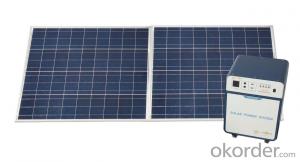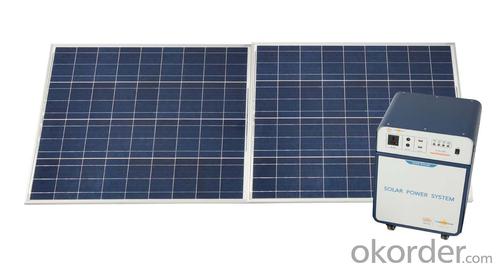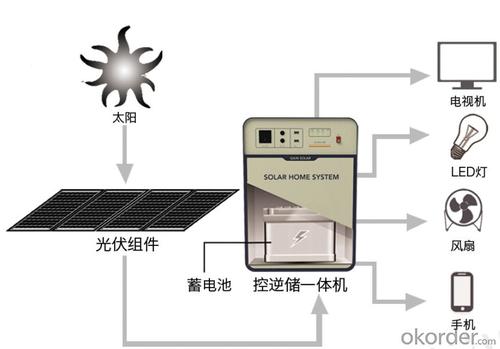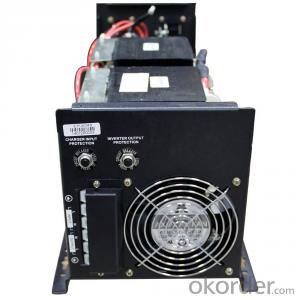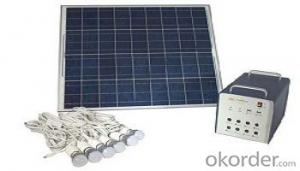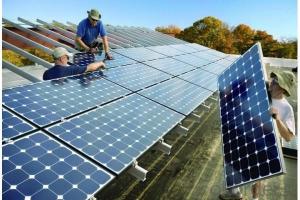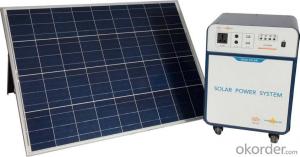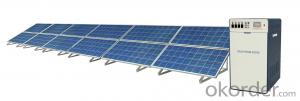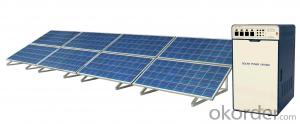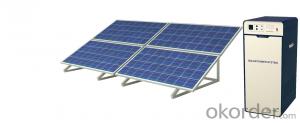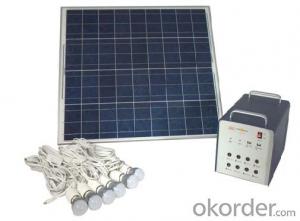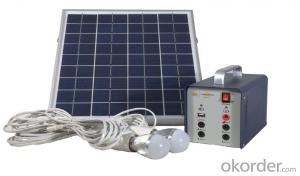Greenlogic Solar Energy Systems - Off-Grid Solar Power System JS-SPS-300
- Loading Port:
- Tianjin
- Payment Terms:
- TT or LC
- Min Order Qty:
- 10 set
- Supply Capability:
- 10000 set/month
OKorder Service Pledge
OKorder Financial Service
You Might Also Like
General Introduction
Solar power system provides alternating current and direct current, which is produced by the modules transforming solar power into power, to home lighting, household appliance and other DC appliance, such as cell phone and laptop.
Solar power system is widely used in area lack of power, for example house power supplying, monitoring, communication base, fire prevention in forest area, pasture and meadow, aquaculture etc.
We are dedicated to provide high quality off-grid PV products and systems to customers and has received a series of certificate, including ISO9001, TUV, UL, CE, CQC and RoHS.
Off-grid Solar Power System
High efficent PV module can produce more power.
Sine wave output is suitable for all kinds of load. Varieties of DC output, let it more convenient for users.
The multifunction design make it easy to operation and maintenance.
Off-grid Solar Power System Parameters
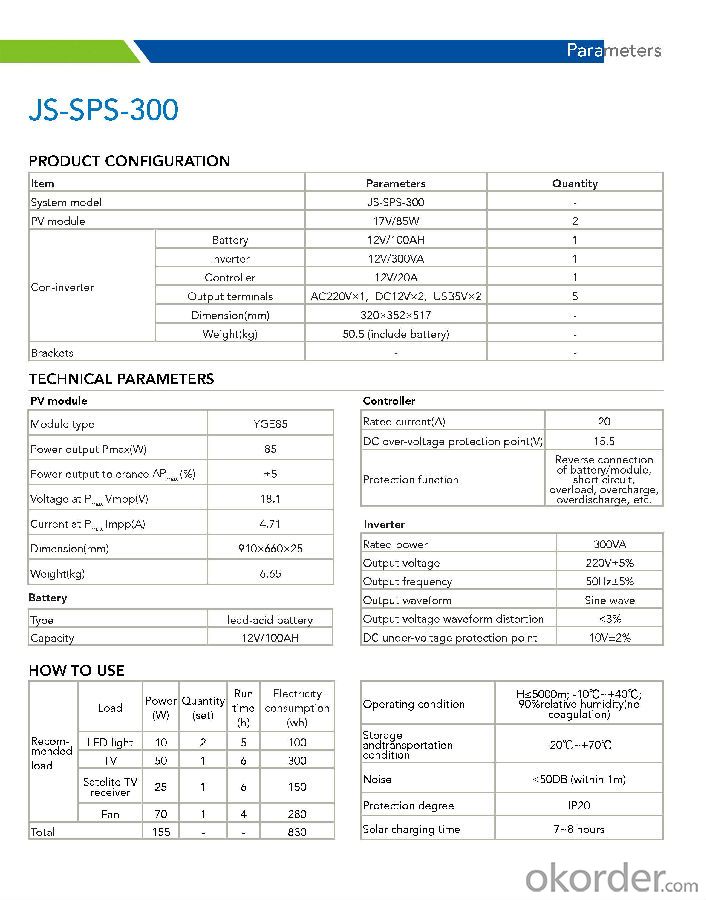
Off-grid Solar Power System Application
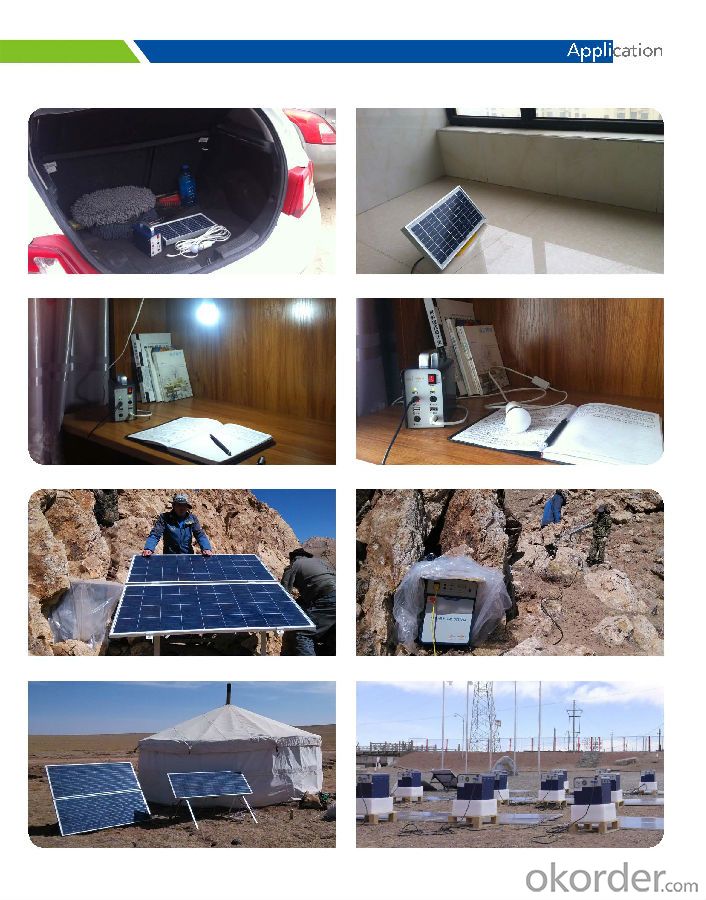
Our Factory

- Q: Can solar energy systems be used for powering shopping malls or retail centers?
- Absolutely, shopping malls and retail centers can definitely utilize solar energy systems to power their operations. In fact, numerous shopping malls and retail centers worldwide have already embraced solar energy systems to meet their energy requirements. These establishments can install solar panels on their rooftops or in parking lots to capture sunlight and transform it into usable electricity. There are numerous advantages to using solar energy systems in shopping malls and retail centers. Firstly, they offer a consistent and reliable source of clean and renewable energy. This decreases reliance on fossil fuels, reduces carbon emissions, and contributes to a more sustainable future. Additionally, solar energy systems can significantly reduce energy costs for these establishments. Once the initial installation costs are covered, the electricity generated by solar panels is essentially free. Furthermore, solar panels can be seamlessly integrated into the architectural design of shopping malls and retail centers, providing a visually appealing and distinctive feature. This can enhance the overall aesthetic appeal of the buildings and attract more customers. Additionally, solar panels can provide shade in parking lots, protecting vehicles from direct sunlight and minimizing the need for air conditioning. However, it is important to consider various factors such as available space, local regulations, and financial considerations when determining the feasibility of installing solar energy systems in shopping malls or retail centers. Effective planning and design are crucial to ensure optimal utilization of solar energy and maximize the associated benefits. All in all, solar energy systems offer a practical and sustainable solution for powering shopping malls and retail centers. Their adoption not only reduces environmental impact but also provides long-term cost savings and promotes a positive brand image for businesses.
- Q: Can solar energy systems be used in powering dental clinics or medical clinics?
- Yes, solar energy systems can definitely be used to power dental clinics or medical clinics. Solar energy is a clean, renewable and sustainable source of power that can be harnessed through photovoltaic (PV) panels to generate electricity. These panels convert sunlight into usable energy, which can then be used to power various electrical equipment and appliances in dental or medical clinics. Dental and medical clinics typically require a significant amount of electricity to run their operations, including lighting, air conditioning, medical equipment, computers, and other electrical devices. By installing solar panels, these clinics can reduce their reliance on the traditional power grid and lower their electricity costs. Solar energy systems can be customized to meet the specific energy needs of dental or medical clinics, ensuring that they can operate smoothly and efficiently. The amount of electricity generated by solar panels can be optimized by determining the clinic's energy consumption patterns and installing an adequate number of solar panels to meet the demand. In addition to cost savings, using solar energy systems also has environmental benefits. Solar power is a clean energy source that produces no greenhouse gas emissions or air pollutants during operation. By switching to solar energy, dental and medical clinics can reduce their carbon footprint and contribute to a healthier environment. Furthermore, solar panels have a long lifespan and require minimal maintenance, making them a reliable and durable energy solution for dental and medical clinics. With proper installation and routine inspections, solar energy systems can provide a consistent and uninterrupted power supply for many years. Overall, solar energy systems are a viable and practical option for powering dental or medical clinics. They offer cost savings, environmental benefits, and a reliable source of electricity, enabling clinics to operate efficiently while reducing their impact on the environment.
- Q: Can solar energy systems be used in areas with high population density?
- Yes, solar energy systems can be used in areas with high population density. Solar panels can be installed on rooftops, buildings, and other available spaces, making them suitable for densely populated areas. Additionally, advancements in solar technology and the ability to install solar farms outside urban areas can help meet the energy demands of densely populated regions.
- Q: Can solar energy systems be used in space exploration?
- Yes, solar energy systems can be and are used in space exploration. Solar energy is a reliable and renewable source of power that can be harnessed even in the harsh conditions of space. Solar panels are commonly used on satellites and spacecraft to provide electricity for various systems and instruments. They convert sunlight directly into electricity through the photovoltaic effect. One of the main advantages of using solar energy in space exploration is its abundance. The sun is a virtually limitless source of energy that can be accessed anywhere in the solar system. This makes solar power an attractive option for long-duration missions, where other sources of energy like batteries or fuel cells would be impractical. Solar energy systems are also lightweight and scalable, making them ideal for use in space. This is crucial as weight is a major concern for space missions due to the high cost of launching objects into space. Solar panels can be easily packed and deployed, providing a compact and efficient solution for generating power. Furthermore, solar energy is a clean and sustainable source of power. Unlike traditional fuel-based systems, solar energy does not produce harmful emissions or waste products, which is important for maintaining the cleanliness of spacecraft and minimizing the impact on the environment. However, it's important to note that solar energy systems have their limitations in space. For missions going beyond the orbit of Mars, where sunlight is significantly reduced, alternative power sources such as nuclear energy or fuel cells may be more suitable. Nonetheless, solar energy remains a crucial and widely used technology in space exploration, playing a key role in powering various scientific experiments, communication systems, and other essential functions.
- Q: What is the difference between solar thermal and solar PV systems?
- Solar thermal systems use sunlight to heat water or other fluids, which can then be used for various purposes like heating buildings or generating electricity. On the other hand, solar PV (photovoltaic) systems directly convert sunlight into electricity using solar panels made up of photovoltaic cells. While solar thermal systems are primarily used for heating, solar PV systems are designed for generating electricity.
- Q: Can solar energy systems be used in areas with limited access to financing options?
- Yes, solar energy systems can be used in areas with limited access to financing options. There are various alternative financing options available such as leasing, power purchase agreements, and community funding that make solar energy more accessible to people in areas with limited financing options. Additionally, government incentives and subsidies can also help reduce the financial burden of installing solar energy systems in such areas.
- Q: What are the different financing options for solar energy systems?
- There are several financing options available for solar energy systems. These include purchasing the system outright with cash or a loan, leasing the system, utilizing power purchase agreements (PPAs), and utilizing solar loans or solar-specific financing programs. Each option has its own benefits and considerations, such as upfront costs, ownership, maintenance responsibilities, and potential tax incentives. It is important to research and compare these options to determine the best fit for individual circumstances and financial goals.
- Q: What is the impact of snow on the performance of solar panels?
- The performance of solar panels can be significantly affected by snow. When snow covers the panels, it hinders sunlight from reaching the photovoltaic cells, thus decreasing their efficiency in generating electricity. This can lead to a significant reduction or even a complete halt in the electricity output during heavy snowfall. Snow accumulation on solar panels also adds extra weight and has the potential to cause damage if the panels are not designed to withstand heavy loads. Moreover, the presence of snow on the panels' surface can cause uneven melting, resulting in water seepage that may damage the electrical components. To address the impact of snow on solar panels, various strategies can be implemented. One common approach is to install the panels at an angle that facilitates the easy sliding off of snow. Additionally, some panels are equipped with special coatings or materials that prevent snow from adhering to the surface. Heating elements can also be integrated into the panels to melt the snow and prevent accumulation. In conclusion, while snow can present challenges for solar panels, proper design, installation, and maintenance can minimize the impact and ensure optimal performance even in snowy conditions.
- Q: Can a solar energy system be used in areas with limited sunlight?
- Yes, a solar energy system can still be used in areas with limited sunlight. While solar panels do require sunlight to generate electricity, they can still produce power even in areas with less sunlight. Additionally, advancements in solar technology, such as the use of more efficient panels and energy storage systems, have made it possible to harness solar energy in regions with limited sunlight.
- Q: What is the impact of roof color on the performance of solar panels?
- The performance of solar panels can be significantly affected by the color of the roof, although it mainly depends on the type of solar panel technology being used. The color of the roof can have an impact on the overall efficiency and output of solar panels due to its influence on sunlight temperature and reflection. Solar radiation absorption and reflection are influenced by roof color. Dark-colored roofs tend to absorb more sunlight, resulting in increased heat accumulation on the roof's surface. This excess heat negatively affects the performance of solar panels, as they function less efficiently at higher temperatures. The elevated temperature can lead to a decrease in the overall power output of the panels, reducing their energy generation potential. On the contrary, light-colored roofs reflect more sunlight, which helps prevent excessive heat buildup. By reflecting a significant amount of solar radiation, the roof's color assists in keeping the panels cooler and maintaining their optimal operating temperature. This can lead to better performance and higher energy production from the solar panels. However, it is important to note that the impact of roof color can vary depending on the type of solar panel technology used. Certain types of solar panels, such as monocrystalline or polycrystalline, may be more sensitive to temperature changes and therefore more influenced by roof color. In contrast, thin-film solar panels are generally less affected by temperature variations, making the impact of roof color less significant in their case. Furthermore, factors like climate, local weather conditions, and the orientation and tilt of the solar panels can also have a greater impact on their performance than the roof color alone. Proper installation and maintenance of the solar panel system, including adequate ventilation and shading, can further mitigate the impact of roof color on panel performance. In conclusion, while roof color can affect the performance of solar panels, it is just one of many factors that can influence their efficiency and energy production. To maximize the performance of solar panels, regardless of the roof color, it is essential to consider the specific type of solar panel technology, local environmental conditions, and proper installation practices.
Send your message to us
Greenlogic Solar Energy Systems - Off-Grid Solar Power System JS-SPS-300
- Loading Port:
- Tianjin
- Payment Terms:
- TT or LC
- Min Order Qty:
- 10 set
- Supply Capability:
- 10000 set/month
OKorder Service Pledge
OKorder Financial Service
Similar products
Hot products
Hot Searches
Related keywords
